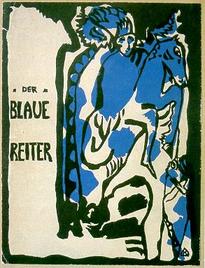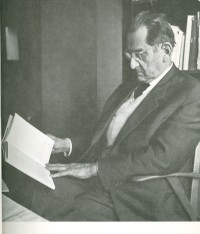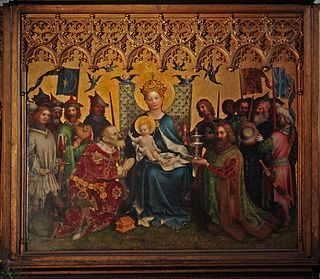Related Research Articles

Modernism is both a philosophical and arts movement that arose from broad transformations in Western society during the late 19th and early 20th centuries. The movement reflected a desire for the creation of new forms of art, philosophy, and social organization which reflected the newly emerging industrial world, including features such as urbanization, architecture, new technologies, and war. Artists attempted to depart from traditional forms of art, which they considered outdated or obsolete. The poet Ezra Pound's 1934 injunction to "Make it New" was the touchstone of the movement's approach.
In music, serialism is a method of composition using series of pitches, rhythms, dynamics, timbres or other musical elements. Serialism began primarily with Arnold Schoenberg's twelve-tone technique, though some of his contemporaries were also working to establish serialism as a form of post-tonal thinking. Twelve-tone technique orders the twelve notes of the chromatic scale, forming a row or series and providing a unifying basis for a composition's melody, harmony, structural progressions, and variations. Other types of serialism also work with sets, collections of objects, but not necessarily with fixed-order series, and extend the technique to other musical dimensions, such as duration, dynamics, and timbre.

Modern art includes artistic work produced during the period extending roughly from the 1860s to the 1970s, and denotes the styles and philosophies of the art produced during that era. The term is usually associated with art in which the traditions of the past have been thrown aside in a spirit of experimentation. Modern artists experimented with new ways of seeing and with fresh ideas about the nature of materials and functions of art. A tendency away from the narrative, which was characteristic for the traditional arts, toward abstraction is characteristic of much modern art. More recent artistic production is often called contemporary art or postmodern art.

Postmodern art is a body of art movements that sought to contradict some aspects of modernism or some aspects that emerged or developed in its aftermath. In general, movements such as intermedia, installation art, conceptual art and multimedia, particularly involving video are described as postmodern.

Dan Flavin was an American minimalist artist famous for creating sculptural objects and installations from commercially available fluorescent light fixtures.

Der Blaue Reiter is a designation by Wassily Kandinsky and Franz Marc for their exhibition and publication activities, in which both artists acted as sole editors in the almanac of the same name, first published in mid-May 1912. The editorial team organized two exhibitions in Munich in 1911 and 1912 to demonstrate their art-theoretical ideas based on the works of art exhibited. Travelling exhibitions in German and other European cities followed. The Blue Rider disbanded at the start of World War I in 1914.

Solomon "Sol" LeWitt was an American artist linked to various movements, including conceptual art and minimalism.
Formula composition is a serially derived technique encountered principally in the music of Karlheinz Stockhausen, involving the projection, expansion, and Ausmultiplikation of either a single melody-formula, or a two- or three-voice contrapuntal construction.

Willi Baumeister was a German painter, scenic designer, art professor, and typographer. His work was part of the art competitions at the 1928 Summer Olympics and the 1932 Summer Olympics.
In the visual arts, late modernism encompasses the overall production of most recent art made between the aftermath of World War II and the early years of the 21st century. The terminology often points to similarities between late modernism and post-modernism although there are differences. The predominant term for art produced since the 1950s is contemporary art. Not all art labelled as contemporary art is modernist or post-modern, and the broader term encompasses both artists who continue to work in modern and late modernist traditions, as well as artists who reject modernism for post-modernism or other reasons. Arthur Danto argues explicitly in After the End of Art that contemporaneity was the broader term, and that postmodern objects represent a subsector of the contemporary movement which replaced modernity and modernism, while other notable critics: Hilton Kramer, Robert C. Morgan, Kirk Varnedoe, Jean-François Lyotard and others have argued that postmodern objects are at best relative to modernist works.

Abraham David Christian is a German sculptor.
Modular art is art created by joining together standardized units (modules) to form larger, more complex compositions. In some works the units can be subsequently moved, removed and added to – that is, modulated – to create a new work of art, different from the original or ensuing configurations.

The Museum für Kunst und Kulturgeschichte or MKK is a municipal museum in Dortmund, Germany. It is currently located in an Art Deco building which was formerly the Dortmund Savings Bank.

Ronald Bladen was an American painter and sculptor. He is particularly known for his large-scale sculptures. His artistic stance, was influenced by European Constructivism, American Hard-Edge Painting, and sculptors such as Isamu Noguchi and David Smith. Bladen in turn had stimulating effect on a circle of younger artists including Carl Andre, Donald Judd, Sol LeWitt and others, who repeatedly referred to him as one of the ‘father figures’ of Minimal Art.

Kurt Badt was a German art historian.

The term Cologne School of Painting was first applied in the 19th century to describe old German paintings generally. It subsequently came to refer more specifically to painters who had their workshops in medieval Cologne and the lower-Rhine region from about 1300 to 1550.
Jean André Evard was a Swiss painter and drafter. His special significance lies in the field of constructive art. He is counted among the first artists who did not work figuratively. In the course of his life he produced hundreds of oil paintings, a large number of drawings as well as approximately 2000 to 3000 watercolor and gouache paintings.

Art – Das Kunstmagazin is a monthly art magazine founded by Wolf Uecker and first published by Gruner + Jahr in 1979. Its original editor-in-chief, Axel Hecht, was replaced by Tim Sommer in 2005. The magazine features both new and established contemporary artists across all disciplines as well as reports on exhibitions and projects.

Divided into three houses, the Kunstmuseen Krefeld are dedicated in particular to modern and contemporary art. Thanks to the early and consistent orientation, especially under the director Paul Wember, an international reputation has been built up since the late 1950s. In addition to the construction of the Kaiser Wilhelm Museum on Joseph-Beuys-Platz as the main building, the museum has presentation venues for special exhibitions in the villa ensemble Haus Lange and Haus Esters on Wilhelmshofallee. Since 1 September 2016, the museums have been headed by Katia Baudin, former deputy director of the Museum Ludwig in Cologne.
References
- Guderian, Dietmar. 1985. “Serielle Strukturen und harmonikale Systeme.” In Vom Klang der Bilder: die Musik in der Kunst des 20. Jahrhunderts, edited by Karin von Maur, 434–37. Munich: Prestel-Verlag.
- Hunter, Sam, and John Jacobus. 1986 Modern Art . Englewod Cliffs, NJ: Prentice-Hall Inc; New York: Harry Abrams Inc.
- Sykora, Katharina. 1983. Das Phänomen des Seriellen in der Kunst: Aspekte einer künstlerischen Methode von Monet bis zur amerikanischen Pop Art. Würzburg: Könighausen + Neumann.